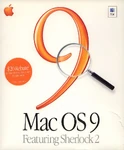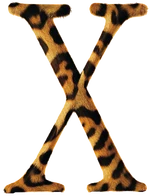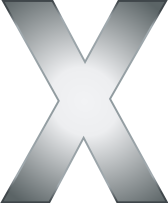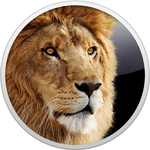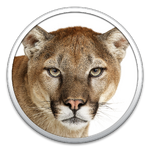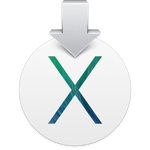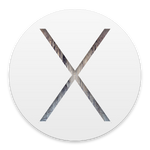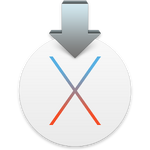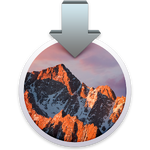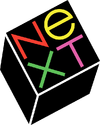| 1991–2009 | 2012–present | 2016–present | 2017–present |
Macintosh System Software
System 1.0–6.0.2 (1984–1996)
System 6.0.2–6.0.8L (1988–1997)
Mac OS
1991–2009
System 7/Mac OS 7 (1991–2007)
| BETTER LOGO NEEDED |
Mac OS 8 (1997–2007)
| SVG NEEDED |
Mac OS 9 (1999–2009)
| SVG NEEDED |
Mac OS X
Cheetah, Puma (2001–2009)
This logo was used for the Mac OS X v10.0, code named "Cheetah", and v10.1, code named "Puma". These versions were preceded by the Mac OS X Public Beta, code named "Kodiak". This version was made for software developers to be able to create their software so it was ready for the release of v10.0. Cheetah and Puma were the first major releases of the operating system, and were branded with a thin, light blue "X" representing the brand. Following v10.0 and v10.1, Mac OS X v10.2 was released with a rebranded logo, despite this logo still remaining as the foundation of the next logo and in some parts of the interface, including the about screen and others.
Note: Each time period for each Mac OS X Version starts with the year the OS was released and ends with the year of the end of its support. This applies to OS X and macOS as well.
Jaguar (2002–2009)
In 2002, Mac OS X v10.2, code named "Jaguar", was released with a brand new logo. The logo was an "X" that had a jaguar print instead of the previous blue "X". This was the first release of Mac OS X in which the OS was actually marketed using the code name, Jaguar. Following v10.2, Mac OS X Panther was released in 2003.
Panther (2003–2009)
Mac OS X Panther was released in November 2003, with the logo redesigned into a thick, gray "X". Panther was followed by Tiger in late April of 2005.
Tiger (2005–2016)
Mac OS X Tiger was released on April 29, 2005, with the "X" transformed into a metallic, bright "X". The operating system included many new features and became the best-selling system in comparison to its predecessors. In 2007, Leopard was released to follow Tiger.
Leopard, Snow Leopard (2007–2016, 2009–2019)
On October 26, 2007, Mac OS X Leopard was released. The logo was redesigned into a glistening, black "X". The Leopard system also brought a major redesign to the interface itself. Following Leopard, Mac OS X Snow Leopard was released in 2009. There were no changes made to the logo, especially when installing OS X Lion (2011) or Mountain Lion (2012), until the release of OS X Mavericks in 2013. The primary reason for this is that Snow Leopard was intended to be a refined and more efficient version of Leopard instead of a complete redesign of the system's interface or features. Snow Leopard is still being sold on the Apple website, but is not recommended to use due to security vulnerabilities.
Lion (2011–present)
Mac OS X Lion was released in 2011, with the classic "X" being abandoned in this release. The logo was instead replaced with a circle containing an image of a lion. Lion was intended to be only available from the Mac App Store, unlike previous operating systems. Following Lion, Mountain Lion was released only a year later. Lion is still available on Apple's website.
OS X
2012–present
====Mountain Lion (2012–present)====
OS X Mountain Lion was released in 2012, with a simple change from the previous logo. The lion in the previous logo was replaced with a mountain lion. The system was dubbed "Mountain Lion" to signify its purpose as a refinement from Lion. Along with that, Mountain Lion was also made to enable better synchronization between iOS devices and OS X. Mountain Lion is succeeded by 10.9 Mavericks which followed a year later. Mountain Lion remains available on Apple's online store for purchase.
Mavericks (2013–present)
| BETTER LOGO NEEDED |
OS X 10.9 Mavericks was announced at WWDC 2013 with the X returning in this version along with the green and blue tsunami wave inside it, and new features are available in this version. This was the first operating system in OS X family to stop naming after cats and start naming after landmarks in California. It was released later that year.
Yosemite (2014–present)
OS X 10.10 Yosemite was first revealed at the annual WWDC on June 2, 2014. This release saw yet another major redesign to the OS' interface since Lion in 2011, adopting the flat look since iOS 7, which since then became the standard for all future revisions to the OS family. It finally came out October 16, 2014.
El Capitan (2015–present)
OS X 10.11 El Capitan was announced at WWDC 2015. The X became thinner too. This version was discontinued in late 2018. However, it is still available on the App Store for older Macs.
macOS
2016–present
Sierra (2016–present)
As part of WWDC 2016, OS X revealed a name change to macOS, thus making a throwback to the same name used in the Classic era from versions 7.5.1-9.2.2 (1995-2002). The reason behind this was to make the name "so much cleaner and so much more elegant"[1]. This name took full effect when Apple's latest version of macOS, Sierra came out in September 2016. Sierra is still available on the Mac App Store for older Macs.
2017–present
High Sierra (2017–present)
Mojave (2018–present)
Catalina (2019–present)
References











